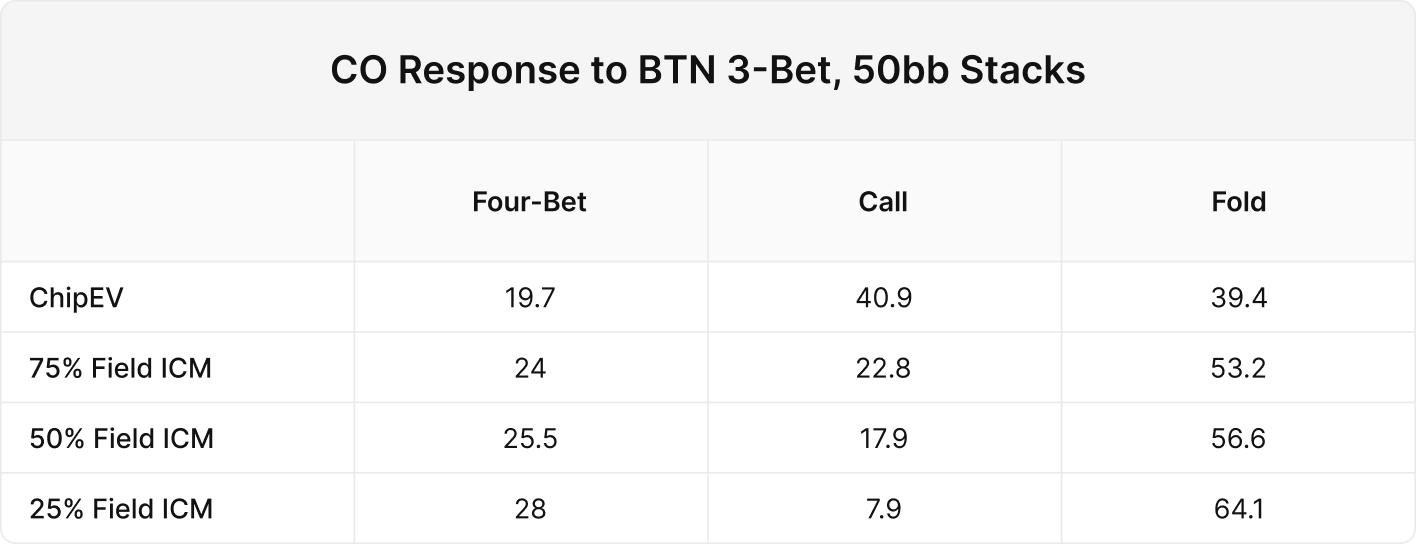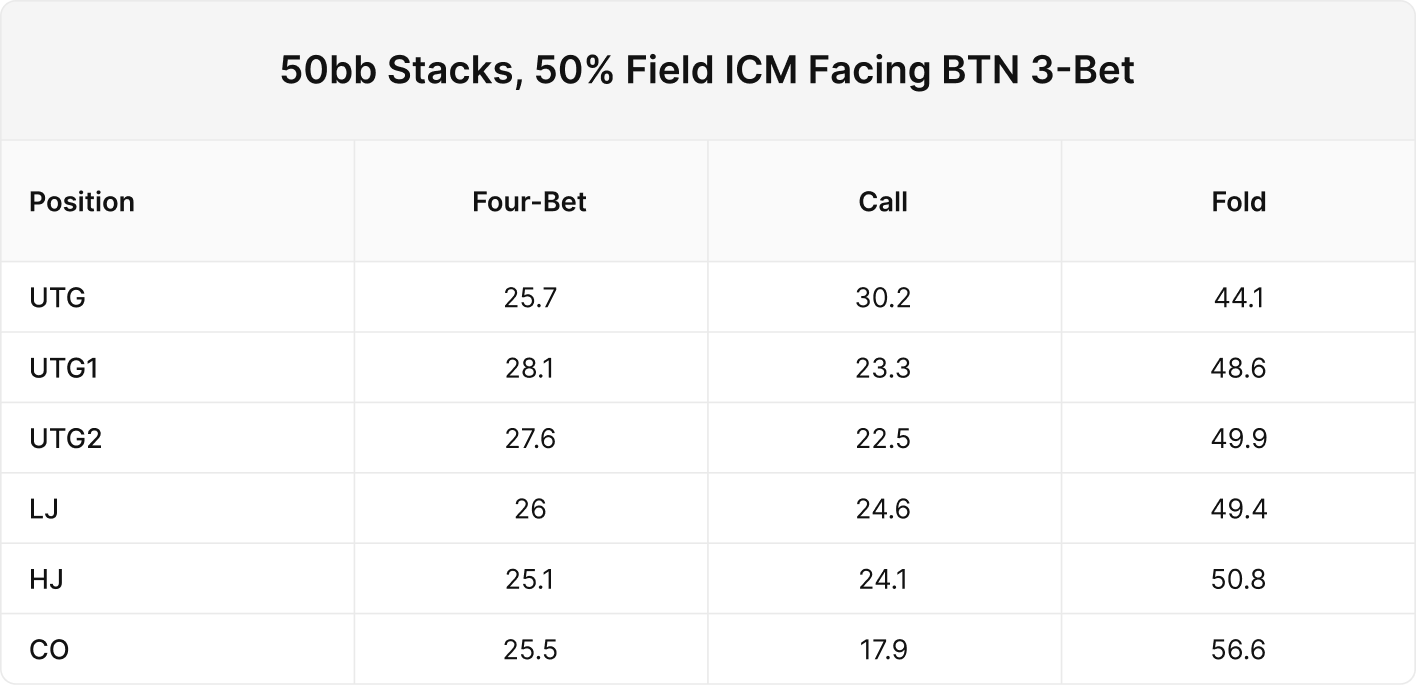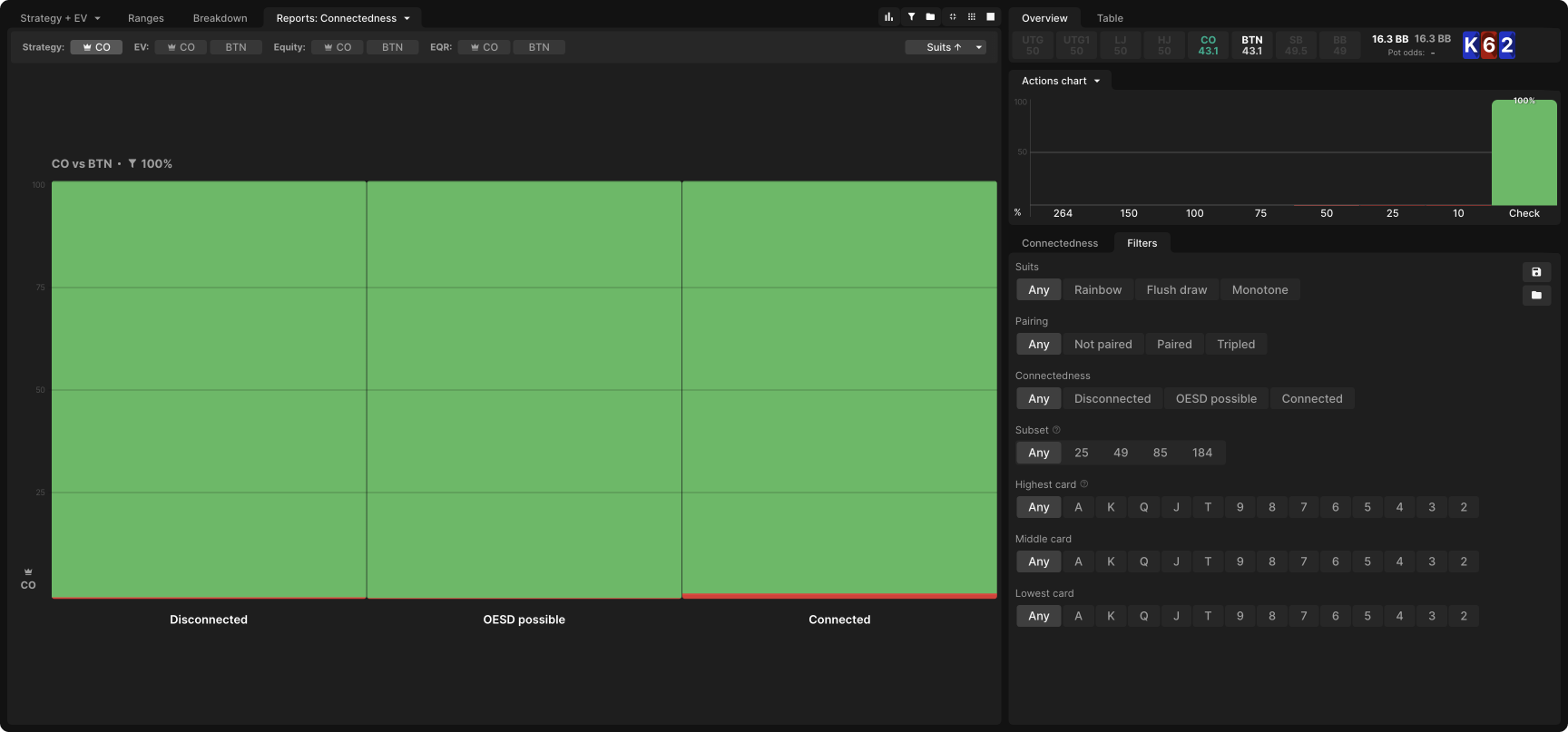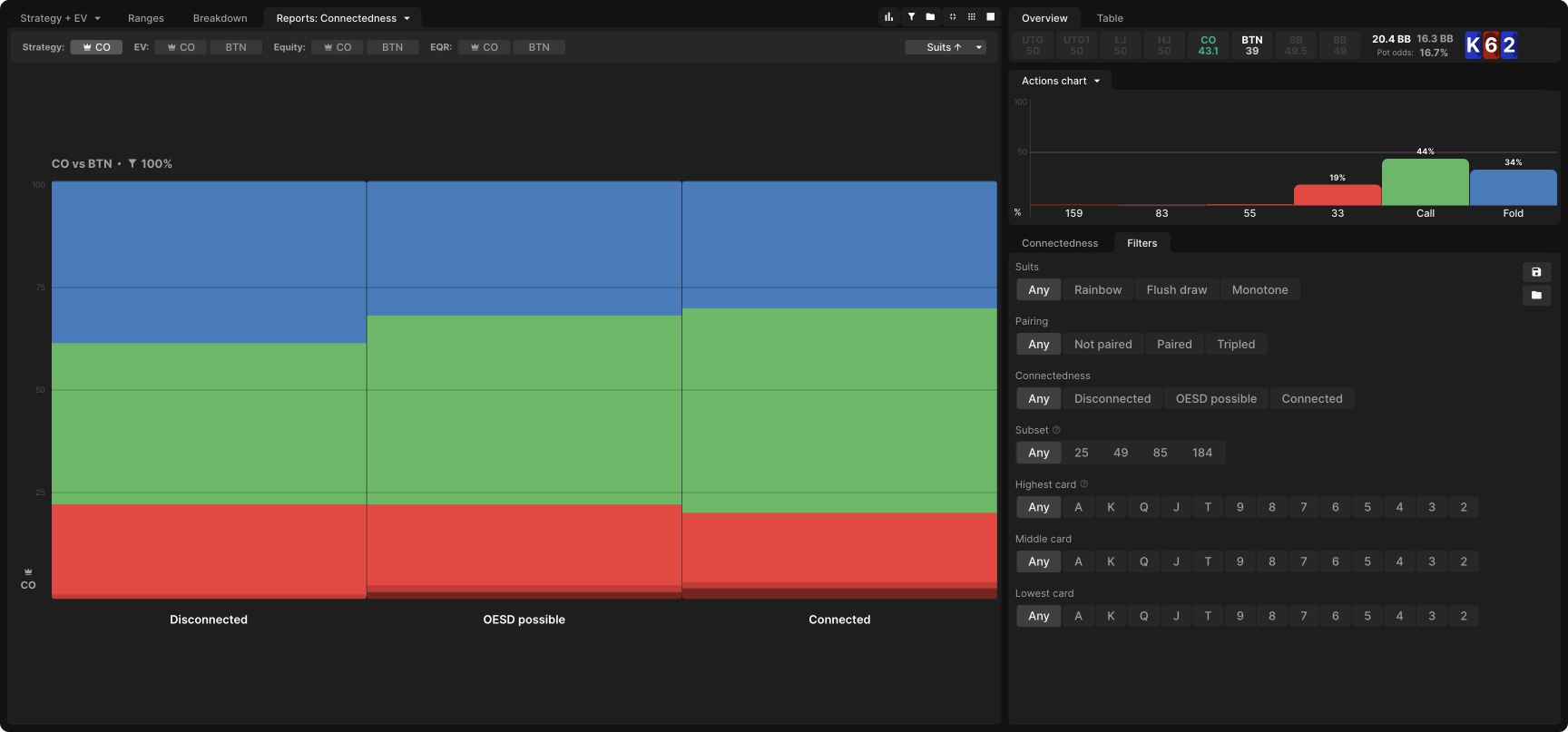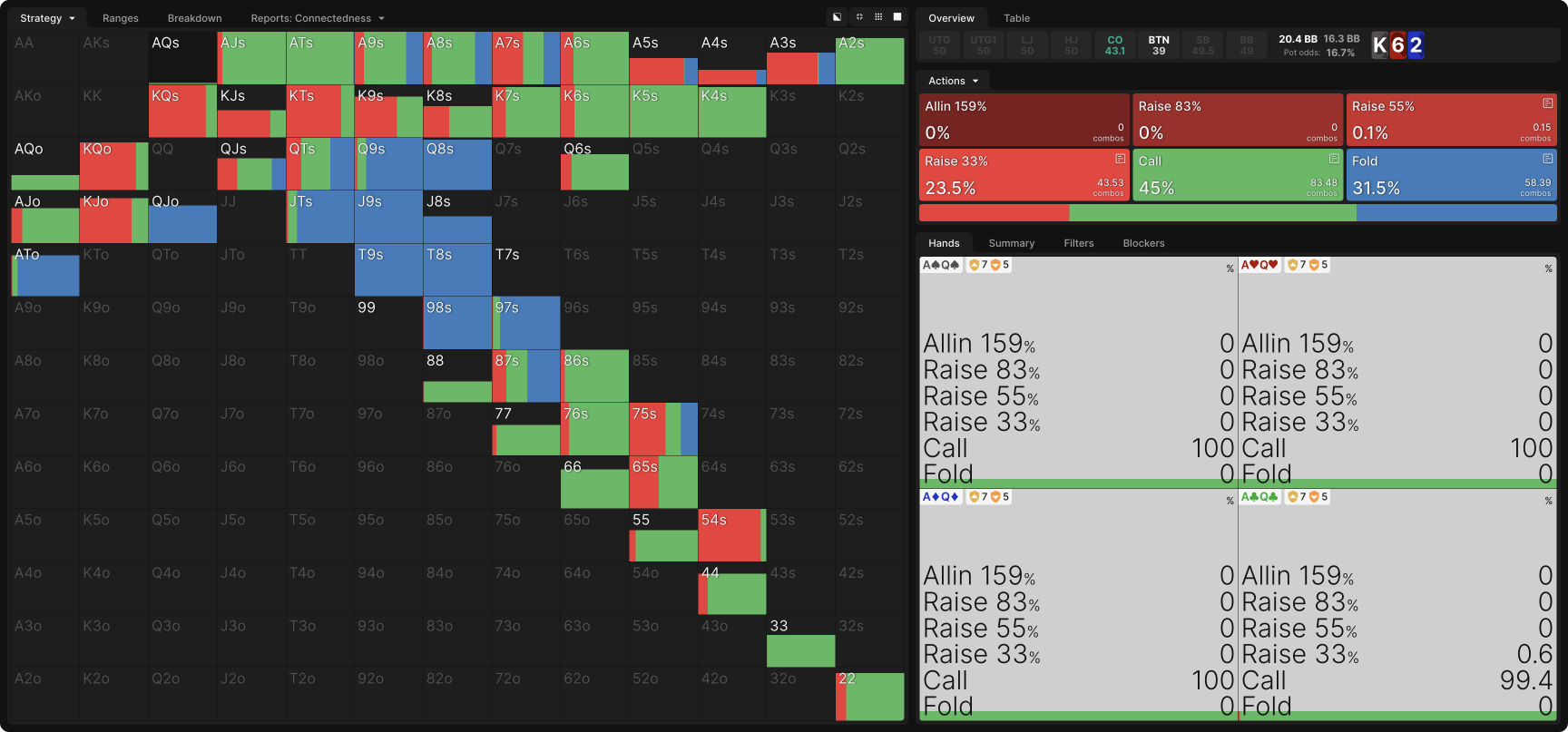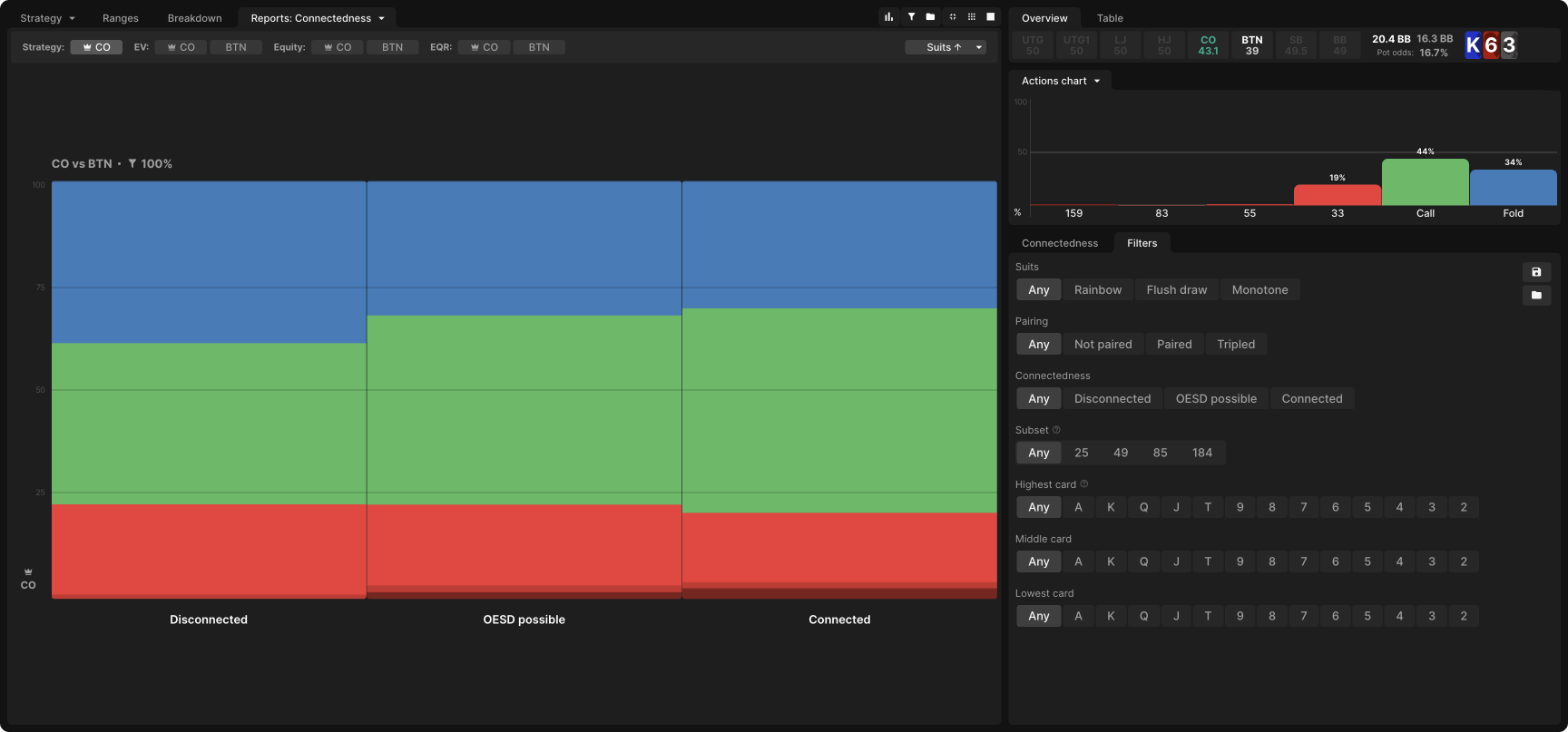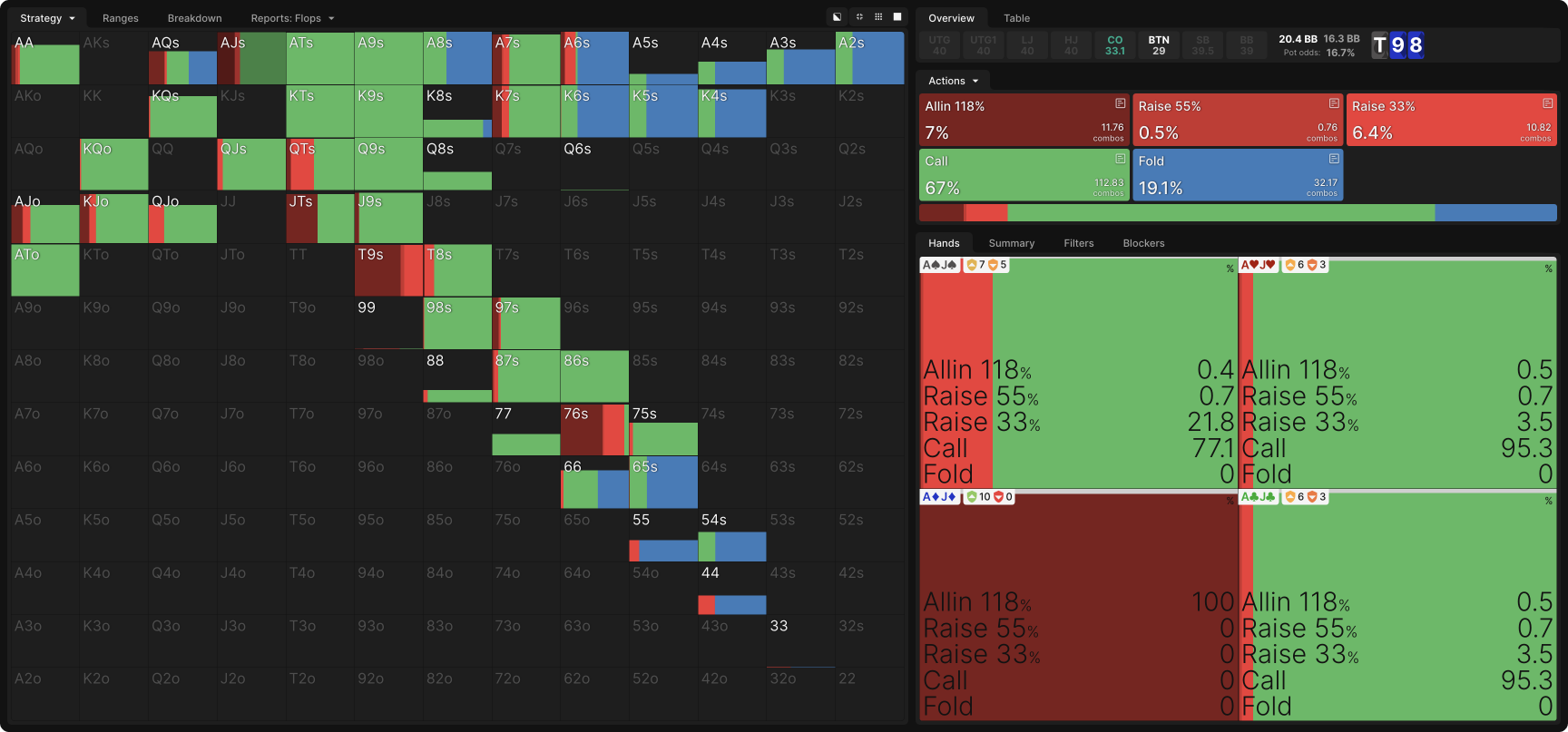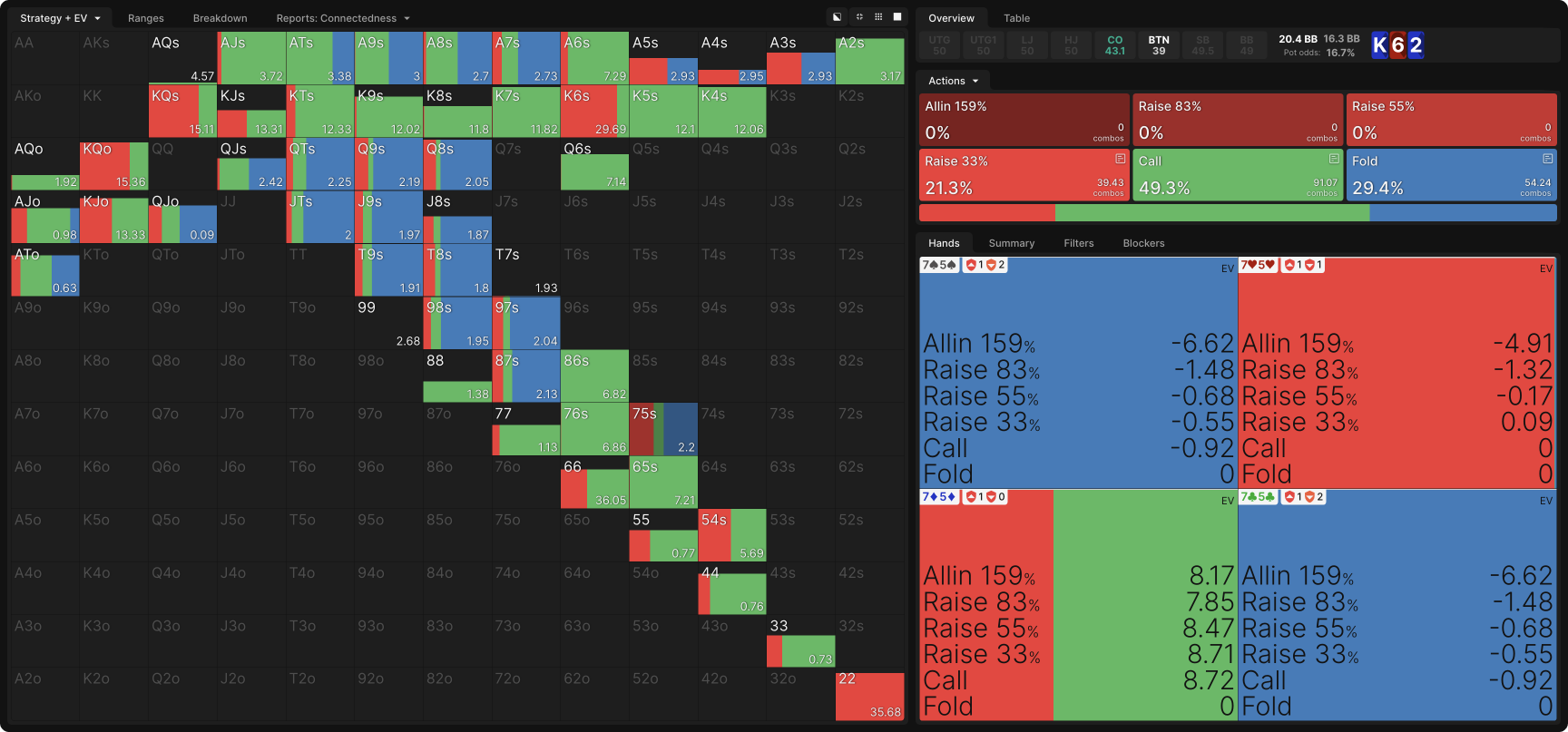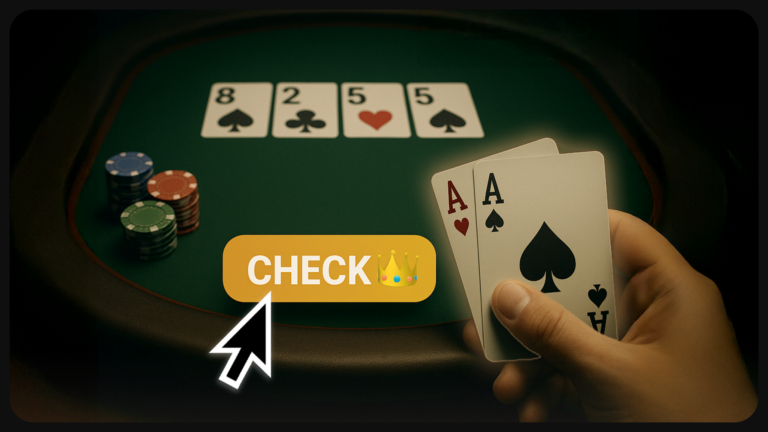Mastering Three-Bet Pots Out of Position in MTTs
Three-bet pots are scary. Playing out of position is scary. Put them together, and you’ve got many a poker player’s nightmare.
As always, the best way to combat that anxiety is to arm yourself with information. Once you understand the principles that guide your play in these tricky situations, you’ll make better decisions in these big, important pots. You’ll still lose them often – that’s baked into the situation, as we’ll see—but you can rest easy knowing your play was sound.
Playing Before the Flop
The first thing to know about playing postflop out of position to a three-bettor in an MTT is that you shouldn’t do it very often. Even mild ICM pressure incentivizes you to four-bet or fold preflop more than you call from out of position.
Calling is a bigger part of your strategy when the stack depth becomes shallower, for two reasons:
- Your opponent’s three-bet should be smaller, offering you better immediate calling odds.
- Being out of position is less of a liability, making it easier to realize equity with marginal hands.
Even so, calling should remain your least frequent action in response to a three-bet from an in position player at all stack depths. Among other things, shallower stacks also make shoving more appealing by reducing the downside risk when all-in.
These numbers remain similar regardless of your position. The composition of the ranges changes to reflect the width of the initial opening range, but facing a three-bet, the opener folds, calls, and four-bets similar proportions of that opening range regardless of their position. This is because the three-betting range takes the original raiser’s position into account. So, while an early position opener will have a stronger range than a late position opener, the raiser’s range for three-betting the early position open will be stronger as well, leading the opener to respond with similar frequencies.
The proportions shown in the chart below reflect modest ICM considerations with 50% of the field remaining. As we have seen, more ICM pressure will result in more folding and less calling.
Playing the Flop
Calling a three-bet from out of position is voluntarily entering a disadvantageous situation because the price is right. You should expect to have a weaker range postflop and to lose more pots than you win.
The caller always has a weaker preflop range than a preflop reraiser in a three-bet pot, for reasons that are similar to why a BB caller has a weaker range than a preflop raiser in a single-raised pot:
- The three-bet risks more than the call. When CO opens to 2.1bb and BTN reraises to 6.82bb, the raise puts 6.82bb at risk, while the call risks only an additional 4.72bb.
- The call closes the action. Whereas the three-bettor risks a four-bet from a player who has not yet acted or, more likely, from the original raiser, the caller can be sure they will see the flop.
- The caller is incentivized to four-bet their strongest hands. Slowplaying is generally risky from out of position, so with the exception of exactly AA, the opener will generally four-bet their strongest hands, leading them to call with a largely cappedCapped range
A range without many very strong hands range.
Much like calling from the BB, calling a three-bet from out of position is voluntarily entering a disadvantageous situation because the price is right. You should expect to have a weaker range postflop and to lose more pots than you win.
It follows from this that you should almost always begin your postflop play by checking to the raiser. Technically, there are some exceptions on the most coordinated boards, those where the three-bettor’s overpairs are weakest, but you should default to checking unless you have an extremely good reason to do otherwise.
CO Donk Betting Strategy in Three-Bet Pot, CO vs BTN, 50bb Stacks
Shallower stacks make donk betting slightly more appealing, but only slightly:
CO Donk Betting Strategy in Three-Bet Pot, CO vs BTN, 20bb Stacks
After checking to the raiser, you will likely face a small continuation bet. This is the three-bettor’s default strategy on most flops. In response, you should most frequently call but do plenty of folding as well.
A tiny continuation bet is not weak.
This is CO’s response to BTN’s 25% pot continuation bet in a three-bet pot with 50bb starting stacks:
Note that a 34% folding frequency is almost double the 20% folding frequency that the Minimum Defense Frequency formula would yield. This reflects the three-bettor’s equity advantage. Just as in a single-raised pot against the BB, the three-bettor paid for this profitable flop bluff by taking on relatively more preflop risk than the caller. As the preflop caller, you should not fight them tooth and nail for the pot, even when their bet is tiny.
Note also that because of the low SPRStack-to-pot ratio (SPR)
The effective stack divided by the size of the pot. SPR is commonly used to gauge the value of implied odds and the relative value of made hands., a tiny continuation bet is not “weak” and does not in any way cap the three-bettor’s range. They will have plenty of leeway to get stacks in with turn and river bets if they wish to do so, so they are not disincentivized from betting small with their strongest hands.
The low SPR also means you do not need a great hand to stack off. On K62r, for instance, CO can check-raise a BTN three-bettor with K8 and barrel off for value on most runouts. Despite starting with 50bb stacks, the SPR on the flop is less than 3, so any top pair is a strong hand. The weaker King-x that does not check-raise will check-call all the way on most runouts.
Sets and two pairs are not so eager to check-raise. They gain less than King-x from denying equity (BTN has a lot of Ace-x which could draw out on K8 but not on 66) and so would rather give rope for BTN to keep bluffing. Many of the hands that would pay off the check-raise will continue betting later streets for value anyway.
Despite what we said before about CO folding at higher than MDF, they nevertheless have a lot of counter-intuitive calls and raises when facing a tiny continuation bet on such a dry board. They never fold a pair and rarely fold Ace-high. The stronger Ace-x make good calls, as they dominate some of BTN’s Ace-x. The weaker Ace-x need a backdoor flush draw to continue (which they have three times out of four) and often check-raise, partly because they can fold out dominating Ace-x.
CO draws the rest of their check-raise bluffs from gutshots and hands with backdoor straight and flush draws. To be clear, these are not particularly strong draws, and raising them is not especially profitable. But there are no strong draws on this board, and CO needs some bluffs, so they might as well do it when they have an outside chance of improving.
Playing Connected Boards
On K♦6♥3♠, CO’s check-raises are exclusively small, regardless of whether there is a flush draw on the board. CO’s check-raises are almost always small, for the same reasons BTN mostly uses a small continuation bet. But there are some exceptions on the most coordinated boards, as can be seen below:
This check-shoving strategy is actually more intuitive to implement. Because the raise is all-in, it’s a smaller and more linearLinear
A range construction that consists of the top-down strongest hands. A linear range might contain nutted to medium strength hands, or value to thin value., equity-dense range. For example, on T♠9♦8♦, CO check-shoves mostly strong draws like AQ and AJ of diamonds and strong but vulnerable made hands like top two pair and the low end of the straight:
For the check-calling strategy, we select the weaker draws, including nut flush draws and most straight draws with overcards. Playing a draw passively from out of position is never ideal, but BTN’s bet is worrisome. This is not a high-frequency bet spot for them. Indeed, they check back more than half their range on this flop. So when they do bet, CO gives that bet a lot of respect and raises much less often than on K62.
Playing Flush Draw Boards
Similar principles apply when introducing a flush draw, such as on K♦6♥2♦. CO check-raises less King-x because they have more strong draws with similarly high equity against BTN’s Ace-x and lower pairs. Their weakest bluffs are still gutshots and backdoor flush draws, which now take the form of two hearts or a single diamond.
Note that 6-x of diamonds, for middle pair and flush draw, is an especially poor raising candidate. Yes, it has a lot of equity, but better hands never fold and the weak hands that do fold have little chance of drawing out. It is better to raise weaker flush draws, which value fold equity more highly, and call with flush draws that have showdown value against BTN’s bluffs (high Ace-x of diamonds also pure calls).
Playing Later Streets
There are too many distinct later street scenarios to provide even an overview of them all here. The good news is that the same strategic principles that guide your play when playing from the BB against a preflop raiser will serve you well when out of position to a three-bettor.
You’ll just need to keep in mind two important variables:
- The SPRStack-to-pot ratio (SPR)
The effective stack divided by the size of the pot. SPR is commonly used to gauge the value of implied odds and the relative value of made hands. will be low, so your threshold for stacking off should be low as well. - Preflop ranges are substantially stronger and more concentrated around high cards.
Following those familiar principles, if you checked and called the flop, you’ll mostly check the turn. If you raised the flop, you’ll mostly bet the turn. The major exceptions will be on cards that dramatically change the board texture. In a three-bet pot, that’s more likely to be an Ace or King than a board-pairing or straight-completing card as it would be in a single-raised pot.
Conclusion
The pots may be larger, but the principles remain the same: Avoid bad situations when you can. If you do call, recognize you are playing from a disadvantage and proceed defensively, with an emphasis on checking, calling, and folding. Assess the strength of your hands contextually, with an eye toward the SPR and the preflop ranges.
Going on the offensive via raising is a lower frequency play but appropriate for strong hands that benefit from denying equity. Bluff only carefully selected weak hands that have the potential to improve. You can’t always avoid losses, but by sticking to these principles, you can avoid mistakes.
Practice
Ready to try it for yourself? These drills have you facing a three-bet from an in position player from various seats and stack sizes. They are all based on Chip EV simulations, so you can practice both preflop and postflop decision-making.
If you want to practice incorporating ICM into your decisions, these ICM drills put you in similar preflop spots (postflop simulations based on ICM models are not yet available) with 50% of the field remaining. Once you’ve got the hang of that, you can tweak the parameters to practice other stages of the tournament, but you’ll likely get more out of focusing on one stage at a time rather than training on a set of drills that randomly draws from many different ICM models.
Ready to try it for yourself? These drills have you facing a three-bet from an in position player from various seats and stack sizes. They are all based on Chip EV simulations, so you can practice both preflop and postflop decision-making.
If you want to practice incorporating ICM into your decisions, these ICM drills put you in similar preflop spots (postflop simulations based on ICM models are not yet available) with 50% of the field remaining. Once you’ve got the hang of that, you can tweak the parameters to practice other stages of the tournament, but you’ll likely get more out of focusing on one stage at a time rather than training on a set of drills that randomly draws from many different ICM models.
Author
Andrew Brokos
Andrew Brokos has been a professional poker player, coach, and author for over 15 years. He co-hosts the Thinking Poker Podcast and is the author of the Play Optimal Poker books, among others.

